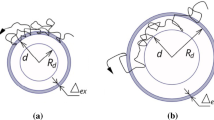Abstract
The phase of the primary electron spin echo signal was analyzed on model radical pairs (RPs) in a singlet spin state. An interpretation is given of the fact known in the literature that the echo signal of such pairs may not have a component with a “normal” phase, which is expected for the echo signal of non-interacting unpaired electrons in the RP. For the first time, it has been theoretically shown that forbidden EPR transitions can make a significant contribution to the phase shift of the magnetization of RP spins, caused by the dipole–dipole hyperfine interaction of unpaired RP electrons with magnetic nuclei. The “anomalous” phase of the spin echo signal of interacting spins in radical pairs is a demonstration that spin dynamics is accompanied by reversible transitions of dipole polarization (spin magnetization) and quadrupole spin polarization.




Similar content being viewed by others
Availability of Data and Materials
Not applicable.
References
K.M. Salikhov, Yu.N. Molin, R.A. Sagdeev, A.L. Buchachenko, Spin polarization and magnetic effects in radical reactions (Elsevier Science Ltd, New York, 1984)
K. Brettel, W. Leibl, Biochim et Biophys Acta (BBA) Bioenergetics. 1507, 100 (2001)
K. M. Salikhov. In Proceedings of SPIE—The International Society for Optical Engineering (2005). pp. 52–61.
K.M. Salikhov, C.H. Bock, D. Stehlik, Appl. Magn. Reson. 1, 195 (1990)
K.M. Salikhov, Appl. Magn. Reson. 25, 261 (2003)
K.M. Salikhov, J.H. Golbeck, D. Stehlik, Appl. Magn. Reson. 31, 237 (2007)
H. Mao, G.J. Pažėra, R.M. Young, M.D. Krzyaniak, M.R. Wasielewski, J. Am. Chem. Soc. 145, 6585 (2023)
B.K. Rugg, M.D. Krzyaniak, B.T. Phelan, M.A. Ratner, R.M. Young, M.R. Wasielewski, Nat. Chem. 11, 981 (2019)
E.L. Hahn, Phys. Rev. 80, 580 (1950)
K.M. Salikhov, A.G. Semenov, Y.D. Tsvetkov, Elektronnoe spinovoe echo i ego primenenie (Nauka, Sibirian branch, Novosibirsk, 1976)
A. Schweiger, G. Jeschke, Principles of pulse electron paramagnetic resonance (Oxford University Press, Oxford, 2001)
A. Abragam, The principles of nuclear magnetism (Clarendon Press, Cary, 1961)
M.C. Thurnauer, M.K. Bowman, J.R. Norris, FEBS Lett. 100, 309 (1979)
M.C. Thurnaur, J.R. Norris, Chem. Phys. Lett. 76, 557 (1980)
K.M. Salikhov, Yu.E. Kandrashkin, A.K. Salikhov, Appl. Magn. Reson. 3, 199 (1992)
M.K. Bowman, H. Chen, A.G. Maryasov, Z. Phys. Chem., 231, 637–652 (2017)
K.M. Salikhov, J. Exp. Theor. Phys. 135, 617 (2022)
A.A. Sukhanov, M.D. Mamedov, K. Möbius, A.Yu. Semenov, K.M. Salikhov, Appl. Magn. Reson. 49, 1011 (2018)
A.A. Sukhanov, M.D. Mamedov, G.E. Milanovsky, K.M. Salikhov, A.Yu. Semenov, Biochem. Mosc. 87, 1109 (2022)
A.A. Sukhanov, M.D. Mamedov, K. Möbius, A.Yu. Semenov, K.M. Salikhov, Appl. Magn. Reson. 51, 909 (2020)
H.C. Torrey, Phys. Rev. 76, 1059 (1949)
Acknowledgements
The study was supported by the Russian Science Foundation and by the Cabinet of Ministers of the Republic of Tatarstan within the framework of the scientific project no. 22-23-20165 (https://rscf.ru/project/22-23-20165/).
Funding
The study was supported by the Russian Science Foundation and by the Cabinet of Ministers of the Republic of Tatarstan within the framework of the scientific project no. 22-23-20165 (https://rscf.ru/project/22-23-20165/).
Author information
Authors and Affiliations
Contributions
KS: wrote the main manuscript text and performed main calculations. IK: prepared figures and performed calculations. AS: carried out experimental measurements.
Corresponding author
Ethics declarations
Conflict of Interest
The authors declare that they have no competing interests.
Ethical Approval
Not applicable.
Additional information
Publisher's Note
Springer Nature remains neutral with regard to jurisdictional claims in published maps and institutional affiliations.
Rights and permissions
Springer Nature or its licensor (e.g. a society or other partner) holds exclusive rights to this article under a publishing agreement with the author(s) or other rightsholder(s); author self-archiving of the accepted manuscript version of this article is solely governed by the terms of such publishing agreement and applicable law.
About this article
Cite this article
Salikhov, K.M., Sukhanov, A.A. & Khairutdinov, I.T. Features of the Primary Electron Spin Echo Signal for Spin-Correlated Radical Pairs. Appl Magn Reson 55, 463–475 (2024). https://doi.org/10.1007/s00723-023-01636-6
Received:
Revised:
Accepted:
Published:
Issue Date:
DOI: https://doi.org/10.1007/s00723-023-01636-6




